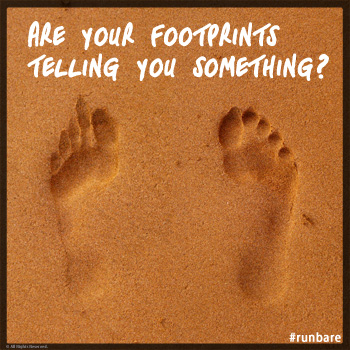What Are Your Footprints Telling You?
 Footprints can tell quite a tale. They can show asymmetries, weaknesses, future injuries, form challenges and things about our body we didn’t know. We try to get down for a sunset walk along the beach every evening, but for months I was only registering Michael's odd footprint on a subconscious level. Something finally clicked last week.
Footprints can tell quite a tale. They can show asymmetries, weaknesses, future injuries, form challenges and things about our body we didn’t know. We try to get down for a sunset walk along the beach every evening, but for months I was only registering Michael's odd footprint on a subconscious level. Something finally clicked last week.
On the left are Michael’s footprints on the beach. Do you see the dragging of the second toe on the left foot? Naturally I just figured he was just being lazy, not lifting his feet enough as he walked. Only thing is his right footprint looked "normal". And then it dawned on me, with all of the extra hardware and "carpentry" (aka surgeries), Michael's left leg is nearly an inch longer than the other. Turns out Michael was walking a bit asymmetrically lifting his left leg slightly less than the right, and therefore slightly dragging his second toe on the ground.
Michael explains: It’s caused by my leg length discrepancy, a condition which shows itself when I'm working too much and walking and running too little (which makes sense with tour preparations).
To fix this, Michael needs to walk more aware of his footsteps, focusing on engaging his core (to keep his hips level) and making sure he lifts his longer leg off the ground as much as his shorter leg.
An interesting aside: Note the sand mark with his second toe. Michael’s dragging the second toe, which is slightly longer than the rest. This is typically called a Morton’s Toe* named by Dr. Dudley Morton

About ten percent of the population have this condition, considered a “deformity” though it’s very natural for the foot.
Out of a shoe this toe has no problems, but in a typically shoe, it can be a big challenge and lead to Morton’s Neuroma, a nerve condition caused by squashing of the second toe in a shoe. It has also been associated with a slew of other health conditions, which are really caused by ill-fitting footwear, not a “deformed” toe. Often treated with orthotics at best, and surgery at worst, Morton’s Toe is a shoe related condition. Without shoes, or in shoes with a naturally shaped toe-box (one that doesn’t come to a point in the middle) the “problem” or challenges of a longer second toe don’t exist. But in traditional running, casual or dress shoes with a tapered or pointy-toed front, it can lead to crippling pain. The answer, get out of the offending shoes.
Fun Factoid: Morton’s Toe is also known as a “Classic Greek Foot” and is featured by the proud bare feet on the Statue of Liberty.
- jessica's blog
- Log in to post comments
